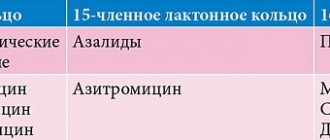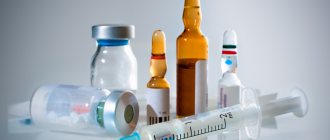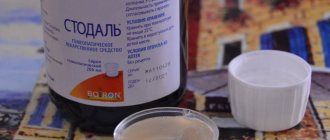What does Nimesulide help with and indications for use?
Before using the drug, consult a doctor.
It is important to remember that Nimesulide does not affect the causes of diseases and does not treat them. This drug is symptomatic and is used to relieve and alleviate clinical manifestations.
The main indications for taking the drug are:
- Diseases of the musculoskeletal system with severe pain (arthritis of various origins, including rheumatoid, bursitis, tendonitis, osteoarthritis, myalgia).
- Early postoperative period.
- Headache or toothache.
- Periodic pain in women.
Nimesulide
Undesirable side effects can be minimized by using the drug in the minimum effective dose with the minimum duration of use necessary to relieve pain.
There is evidence of very rare cases of serious reactions from the liver, including cases of death, associated with the use of nimesulide-containing drugs. If symptoms similar to signs of liver damage appear (anorexia, itching, yellowing of the skin, nausea, vomiting, abdominal pain, dark urine, increased activity of liver transaminases), you should immediately stop using nimesulide and consult a doctor. Repeated use of nimesulide in such patients is contraindicated. After 2 weeks of using the drug, monitoring of liver function parameters (“transaminases”) is necessary.
Liver reactions, which are in most cases reversible, have been reported with short-term use of the drug.
While using nimesulide, the patient should refrain from taking other analgesics, including NSAIDs (including selective COX-2 inhibitors).
Nimesulide should be used with caution in patients with a history of gastrointestinal diseases (ulcerative colitis, Crohn's disease), since exacerbation of these diseases is possible.
The risk of gastrointestinal bleeding, peptic ulcer/perforation of the stomach or duodenum increases in patients with a history of gastrointestinal ulceration (ulcerative colitis, Crohn's disease), as well as in elderly patients, with an increase in the dose of NSAIDs, so treatment should begin with the lowest possible dose. In such patients, as well as in patients who require the simultaneous use of low doses of acetylsalicylic acid or other drugs that increase the risk of complications from the gastrointestinal tract, it is recommended to additionally prescribe gastroprotectors (misoprostol or proton pump blockers). Patients with a history of gastrointestinal disease, especially older patients, should report new gastrointestinal symptoms (especially symptoms that may indicate possible gastrointestinal bleeding) to their physician.
Nimesulide should be administered with caution to patients taking drugs that increase the risk of ulceration or bleeding (oral corticosteroids, anticoagulants such as warfarin, selective serotonin reuptake inhibitors or antiplatelet agents such as acetylsalicylic acid). If gastrointestinal bleeding or gastrointestinal ulceration occurs in patients taking nimesulide, treatment with the drug must be stopped immediately.
Given reports of visual disturbances in patients taking other NSAIDs, if any visual disturbance occurs, the use of nimesulide should be immediately discontinued and an ophthalmological examination performed.
The drug may cause fluid retention in tissues, so patients with arterial hypertension, renal and/or heart failure, coronary heart disease, peripheral arterial disease and/or cerebrovascular diseases, with risk factors for the development of cardiovascular diseases (for example, hyperlipidemia, diabetes mellitus) diabetes, smokers) nimesulide should be used with extreme caution. If the condition worsens, treatment with nimesulide should be discontinued.
Clinical studies and epidemiological data suggest that NSAIDs, especially in high doses and with long-term use, may lead to a slight increase in the risk of myocardial infarction or stroke. There is insufficient data to exclude the risk of such events when using nimesulide.
If signs of a “cold” or acute respiratory viral infection occur during the use of nimesulide, the drug should be discontinued. Nimesulide can change the properties of platelets, so caution must be exercised when using the drug in people with hemorrhagic diathesis, however, the drug does not replace the preventive effect of acetylsalicylic acid in cardiovascular diseases.
Elderly patients are especially susceptible to adverse reactions to NSAIDs, including the risk of life-threatening gastrointestinal bleeding and perforation, and decreased renal, liver, and cardiac function.
When taking nimesulide for this category of patients, proper clinical monitoring is necessary. There is evidence of rare cases of severe skin reactions (such as exfoliative dermatitis, Stevens-Johnson syndrome, toxic epidermal necrolysis) when taking NSAIDs, including nimesulide. At the first manifestations of a skin rash, damage to the mucous membranes or other signs of an allergic reaction, nimesulide should be stopped immediately. The use of the drug may adversely affect female fertility and is not recommended for women planning pregnancy.
Contraindications
The drug is prohibited for gastric and duodenal ulcers, especially in the acute stage, for bleeding disorders and increased bleeding, Crohn's disease, bronchial asthma, inflammatory processes in the intestines, polyposis of the nasal cavity and paranasal sinuses.
Also, the use of Nimesulide is limited in case of individual intolerance to NSAIDs, severe chronic, renal and liver failure, in children under 12 years of age, during pregnancy and lactation.
Side effects and overdose
Taking Nimesulide in some cases may be accompanied by the development of unwanted side reactions. These include:
- From the side of the central nervous system: dizziness, anxiety, headaches, nightmares.
- Urinary system: decreased amount of urine excreted, hematuria, exacerbation of chronic renal failure.
- From the gastrointestinal tract: dyspeptic syndrome (nausea, vomiting, stool disorders), abdominal pain, flatulence, bleeding, gastritis, ulcerative lesions, jaundice as a result of cholestasis, increased transaminases.
- Skin: increased sweating and allergic reactions of varying severity (itching, urticaria, swelling, Stevens-Johnson syndrome).
- From the cardiovascular system: hypotension, increased heart rate.
- Hematopoietic organs: anemia, pancytopenia, increased clotting time.
- Respiratory system: shortness of breath, spasm of smooth muscles in the bronchi, exacerbation of COPD or bronchial asthma.
- Organ of vision: blurred perception.
Symptoms of overdose are similar to those of adverse reactions. They develop due to non-compliance with doctor’s instructions and uncontrolled use of Nimesulide.
In case of overdose, it is necessary to discontinue the drug, lavage the stomach to clean water and take activated carbon at the rate of 1 tablet per 10 kg of body weight.
The use of nimesulides in pediatric practice: pros and cons
Nimesulide is one of the widely used non-steroidal anti-inflammatory drugs (NSAIDs) used in clinical, including pediatric, practice in many countries around the world. Nimesulide's membership in the group of selective cyclooxygenase-2 (COX-2) inhibitors, which results in good gastroenterological tolerability, provides it with clear advantages over other NSAIDs and explains the growing popularity of the drug among doctors and patients. At the same time, the higher effectiveness of nimesulides as an antipyretic agent compared to paracetamol and ibuprofen, traditionally used for hyperthermia, proven in numerous controlled clinical trials, as well as the experience in the practical use of drugs of this group that has accumulated in recent years, has led to the fact that many practicing doctors began to give preference to nimesulides over other NSAIDs. The rapidly increasing share of nimesulides in the pharmaceutical NSAID market could not but cause concern among pharmaceutical companies competing for this market. Thus, by 2000, i.e. 15 years (!) after the development and appearance of nimesulide in the pharmacy chain and after the sale by the Swiss development company Helsinn Healthcare of a license for the production of nimesulide to the largest pharmaceutical companies in the world, the active discussions regarding the advisability of using nimesulide due to its potential hepatotoxicity. Popular medical publications, first foreign and now Russian, have become the arena for these discussions, and the analysis of the information published in them cannot always be considered objective. Supporters of limiting the use of nimesulides in pediatric practice often cite as an argument references to literary sources whose titles include the keywords “hepatotoxicity of nimesulides,” although the content of the works indicates the opposite. An example is a large-scale study carried out in Italy by G. Traversa et al. and published in print and on the BMJ website in 2003 under the title “Cohort study of hepatotoxity associated with nimesulide and other nonsteroidal anti-inflammatory drugs.” The study was devoted to studying the population frequency of hepatotoxic reactions associated with taking nimesulide and other NSAIDs, and covered 397,537 patients using NSAIDs, and a total of 2 million prescriptions were analyzed from 1997 to 2001. The total incidence of hepatopathy was 29.8 per 100,000 patient-years and was associated more with other NSAIDs (diclofenac - 39.2 per 100,000 patient-years; ketorolac - 66.8 and ibuprofen - 44.6) than with nimesulide (35.3 per 100,000 patient-years) -years).
It is quite remarkable that during the period from 1985 to 2001, information was collected on only 195 cases (of which 123 were serious) of the development of adverse reactions after the use of nimesulide, despite the fact that about 304 million patients received this drug, and the frequency of hepatopathies that occurred on during treatment with nimesulide, was 0.1 per 100,000. Even more surprising is the fact that from 1985 to 1997, only 25 cases of hepatopathy associated with taking nimesulide were noted, and in the next 3 years this figure increased to 170. Such statistics can be explained either by increased attention to this problem, or by some other reasons. In this regard, it should be noted that recent years have been marked by a rapid surge in the incidence of viral hepatitis, and the spectrum of hepatotropic viral agents is becoming increasingly numerous and diverse, and their mass diagnosis is far from the proper level.
A clear exaggeration of the scale of the problem of NSAID-induced hepatopathies is evidenced by objective data from leading hepatologists, according to whom NSAIDs are actually in last place among the causes of drug-induced liver damage and are many times inferior to such common drugs in terms of the incidence of hepatopathies. like antibiotics. In addition, it is known that NSAID-induced hepatopathies are rare, unpredictable, idiosyncratic side effects and are much more dependent on other factors (including genetic, infectious, nutritional, polypharmacy, alcohol consumption, etc.) than on the actual mechanism of action of NSAIDs. Compared with the risk of developing NSAID-induced gastropathy, which, as has become known in recent years, is relevant not only for adult rheumatological patients, but also for children, the risk of NSAID-associated liver damage is minimal. From this relationship it follows that when choosing NSAIDs, preference should be given to selective COX-2 inhibitors, including nimesulides.
The question of the likelihood that nimesulides are capable of having a hepatoxic effect on the body (in particular, several examples of acute hepatitis in adult patients receiving nimesulide have been described in the literature) has become the focus of attention of pediatric specialists thanks to a series of articles posted on the website BMJ. Some materials in this series concerning the use of nimesulide in children appear to be quite tendentious, unconvincing and overly emotional. For example, in a publication by K. Saha from the University Medical Center in Ohio (USA), there is a call to stop the use of nimesulides in children, although the proposed alternative, acetaminophen (paracetamol), is quite comparable to nimesulide in terms of the frequency of hepatological adverse reactions mentioned in the literature. In Russia, supporters of restricting the use of nimesulide in pediatric practice cite the fact that nimesulide is not registered as a drug used in children in the USA and many European countries, which cannot be considered a sufficiently weighty argument. It should be emphasized that the most common NSAID in Russia, diclofenac sodium, is also practically not used in children with rheumatic diseases in most countries of Europe and North America. In Europe, the most used NSAID is naproxen - a drug that Russian pediatricians are not able to prescribe, since the generics of naproxen currently available on the domestic pharmaceutical market are limited in use in children under 16 years of age, do not have “children’s” dosage forms, and their quality causes complaints from practicing doctors. Regarding NSAIDs in pediatric practice in the USA, it is appropriate to note that during a discussion at the Congress of Pediatricians held in Russia in February 2005, the famous American professor of pediatrics and pediatric rheumatologist from New York T. Lehman admitted that the most commonly used NSAID is indomethacin , although this particular drug has established itself as the most aggressive agent in terms of the development of adverse reactions. In addition, it is known that the most popular of this group of drugs for use in children in the United States is still aspirin, the hepatotoxicity of which is beyond doubt. Moreover, if in relation to nimesulide, adverse hepatological reactions were recorded in adults, then the development of Reye's syndrome (severe liver dysfunction accompanied by acidosis and encephalopathy while taking aspirin) is observed almost exclusively in children. It should also be noted that in the same series of response articles on the BMJ website there are also notes with the exact opposite content under the titles “Defending Nimesulide Use!” (“Let's protect the use of nimesulide!”) and “Science or Commerce?” (“Science or Commerce?”) and provides data on at least 50 cases of the development of Reye’s syndrome as a result of the use of drugs other than aspirin, most often paracetamol. Apparently, in the pathogenesis of Reye's syndrome, as well as other serious adverse reactions, processes associated with drug interactions and the body's response to the active replication of certain viruses play an important role. These data confirm that almost any drug, even the safest one, can act as the last (but not the most important) link in a complex pathogenetic chain leading to adverse consequences. That is why the decision to choose a drug in a specific clinical situation should be made only by a competent doctor, informed about all possible side effects and risks, and over-the-counter use of NSAIDs is possible only for a very limited period of time and only with the use of drugs and those low doses (acetaminophen - 10 mg/kg, ibuprofen - 5–10 mg/kg), which are recognized as safe by WHO. At the same time, every practicing physician must understand that the advantages of a drug are always a continuation of the disadvantages and vice versa. Thus, acetaminophen and ibuprofen are the shortest-acting antipyretic and anti-inflammatory drugs, which determines, on the one hand, their relative safety, and on the other, in some situations, insufficient effectiveness in terms of duration of action.
In an outpatient setting, provided adequate medical supervision is ensured, and in a hospital setting, there is no reason to limit the doctor’s right to choose an effective drug if the drug is approved for use in children and if there are indications for its use. In hospital pediatric practice, doctors sometimes encounter restrictions on the use of nimesulide, which were carried out without sufficient justification at the administrative level. This also applies to hospitals in Moscow and some regions of Russia, which have accumulated many years of successful experience in using “children’s” dosage forms of nimesulide. At the same time, in our country there is a fairly tolerant attitude towards the use of unregistered medicines in pediatric practice. It should be emphasized that the list of NSAIDs approved for use in children, subject to minor age restrictions, includes ibuprofen, indomethacin and only two generics of nimesulide, marketed under the trade names Nise® and Nimulide®. Certain dosage forms of diclofenac sodium, depending on the specific trade name, are approved for use in children over 6, or 12, or 15 years of age. Meloxicam is approved for use in children over 15 years of age, many new NSAIDs are approved only after 18 years of age. Every doctor should understand that an adverse reaction that develops to a drug prescribed by him, depending on whether it is registered for use in the relevant age group, can have various consequences, including legal ones. In this regard, it is appropriate to note that Nise, approved for use from 2 years of age, successfully passed the re-registration procedure in 2004, partly because over 5 years of its use on the domestic pharmaceutical market, no serious adverse reactions induced by with this drug.
Extensive experience in using Nise has been accumulated in the children's clinic of the Institute of Rheumatology. Over 5 years of using the drug in our clinic, in 385 patients aged from 1 year 2 months to 18 years, suffering from various rheumatic diseases, only 16 cases of adverse reactions were noted. The spectrum of adverse reactions included: moderate dyspeptic symptoms that occurred mainly after taking the suspension - in 9 children, a slight (1.5-2.5 times) increase in transaminases - in 2 children, minimal edema syndrome with a tendency to oliguria - in 4 children , as well as a hematological reaction in the form of a tendency to leukopenia and changes in the blood count - in 1 patient. All adverse reactions were easily eliminated by discontinuation of the drug and did not require the use of additional drugs. It should be emphasized that in 369 children, long-term continuous use of the drug (from 1.5 months to 5.2 years) in high doses of 4–5 mg/kg was not accompanied by adverse reactions, including 113 patients who simultaneously received such hepatotoxic drugs , such as methotrexate, cyclosporine A or sulfasalazine, as well as those with a history of hyperfermentemia while taking diclofenac and other NSAIDs.
An increase in the proportion of inpatients and outpatients with juvenile arthritis taking Nise for a long time as monotherapy or as part of complex therapy, from 5–10% in 2000–2001. to 55–64% in 2003–2005. indicates the recent commitment of doctors and patients to the use of this drug.
Analysis of literature data and extensive clinical experience allow today to consider Nise as the drug of choice among NSAIDs when it comes to its use in children.
Arguments in favor of using Nise in children:
- grounds regulating the possibility of use in children starting from 2 years of age;
- release of dosage forms intended for children and providing the ability to select the optimal dosage;
- sufficient effectiveness as an anti-inflammatory agent in children with rheumatic diseases;
- preferential inhibition of COX-2, providing less gastrotoxicity and nephrotoxicity compared to “traditional” NSAIDs;
- antihistamine and antibradykinin action, allowing it to be considered as the drug of choice in children with an allergic predisposition and bronchial asthma;
- chondroprotective effect of nimesulide, relevant for childhood, taking into account the increased vulnerability of the child’s cartilage tissue in conditions of incomplete bone formation.
Of course, a balanced and cautious approach to prescribing nimesulides in pediatric practice is necessary due to the potential risk of adverse reactions, especially with polypharmacy, and the development of comorbid conditions; In all cases, the appropriate procedure for medical monitoring of the safety of therapy should be followed.
For questions regarding literature, please contact the editor.
I. P. Nikishina , Candidate of Medical Sciences Institute of Rheumatology, Moscow
Interactions
Nimesulide increases the activity of antiplatelet agents and anticoagulants. Concomitant use of this drug with diuretics reduces their effectiveness, which can lead to edema, especially in patients with hypertension and renal failure.
Nimesulide also increases the toxicity of cyclosporine and methotrexate. And its simultaneous use with GCS and serotonin reuptake inhibitors significantly increases the risk of bleeding in the digestive tract.






